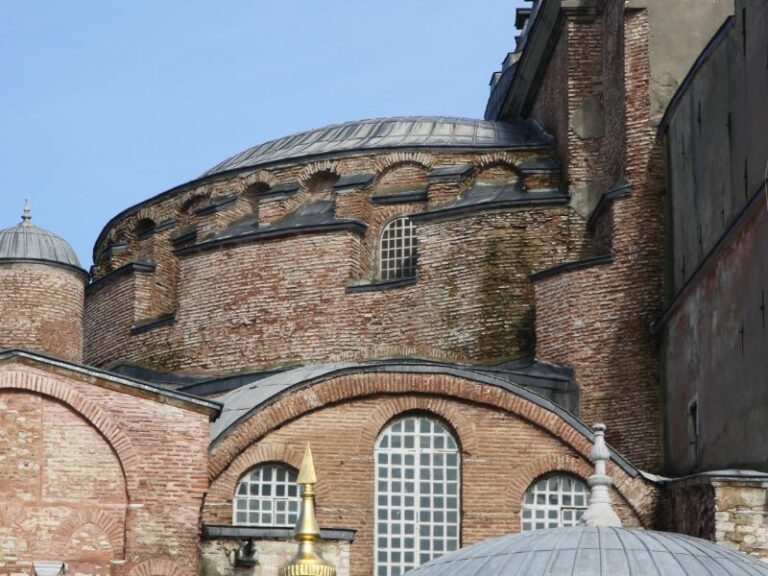Introduction
The Temple of Hadrian in Ephesus stands as a testament to the architectural and cultural prowess of the ancient Roman Empire. Located in one of the most significant archaeological sites in modern-day Turkey, the temple offers rich insights into the religious and social practices of its time.
Erected in honor of Emperor Hadrian, it exemplifies the grandeur and sophistication of Roman temple architecture.
Historical Context
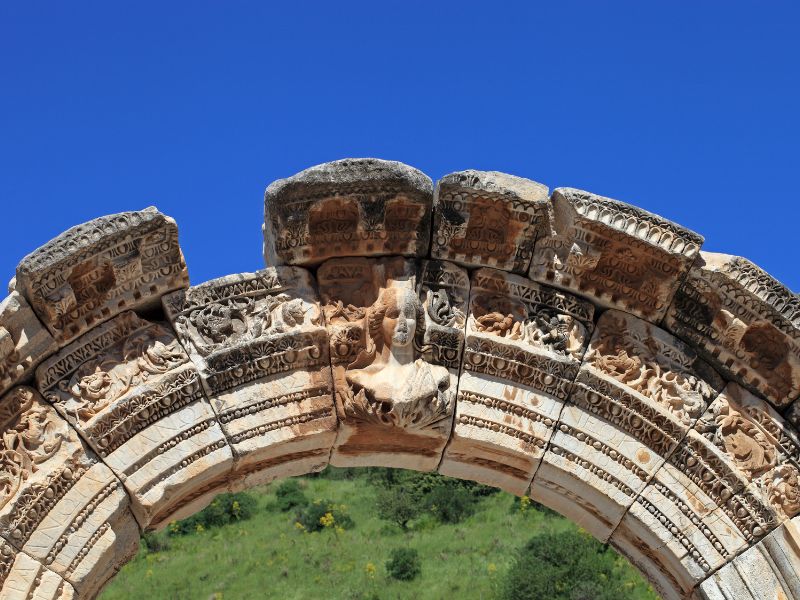
Emperor Hadrian: The Man Behind the Monument
Publius Aelius Hadrianus, commonly known as Hadrian, was born on January 24, AD 76, probably in Rome, though his family’s roots lay in Italica, in modern-day Spain. Hadrian ascended to the throne as one of the Five Good Emperors, a term coined by political philosopher Niccolò Machiavelli in 1532.
This group of emperors, which also included Nerva, Trajan, Antoninus Pius, and Marcus Aurelius, is celebrated for their effective governance and efforts to maintain peace and prosperity within the Roman Empire.
Hadrian’s reign, spanning from AD 117 to 138, was marked by his extensive travels across the empire, his passion for architecture, and his profound influence on Roman culture and society. Unlike his predecessors, Hadrian focused more on consolidating and fortifying the empire’s boundaries rather than expanding them.
His deep interest in Greek culture earned him the nickname “Graeculus” or “Little Greek,” reflecting his admiration for Hellenistic traditions.
The Temple’s Construction and Dedication
The Temple of Hadrian in Ephesus was constructed around AD 138 by P. Quintilius, commemorating Hadrian’s visit to the city from Athens in AD 128. While dedicated to Hadrian, the temple also honored Artemis, the city’s patron goddess, underscoring the religious and cultural significance of the site.
This fusion of imperial and local deities highlights the interconnectedness of Roman and Ephesian beliefs, adding layers of meaning to the temple’s existence.
The Building and the Architectural Insights of the Temple of Hadrian in Ephesus
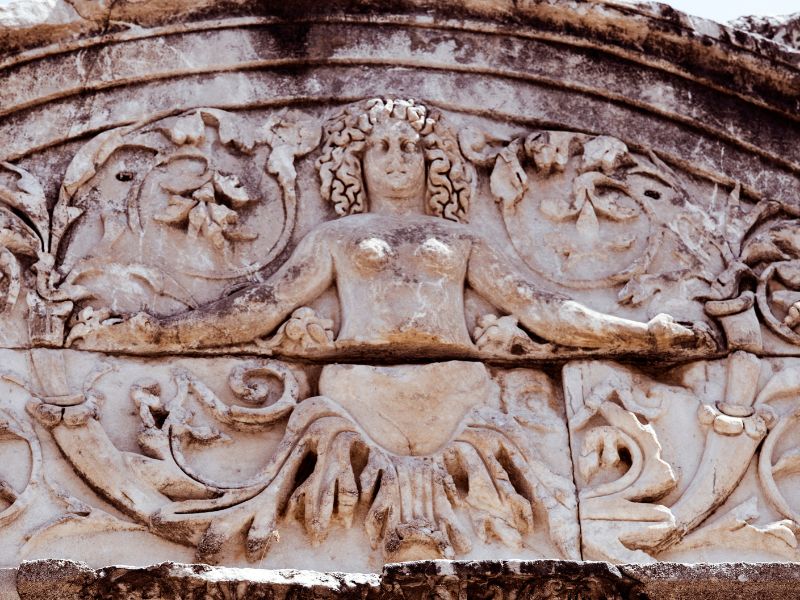
The Temple of Hadrian in Ephesus , prominently situated along the main road of ancient Ephesus, is a masterful integration with the adjoining Scholastikia thermal baths, creating a striking visual unity that reflects Ephesus’s rich architectural heritage.
Architectural Design
The temple’s design features a four-column prostyle layout, enhancing both its aesthetic appeal and functional symmetry. The modestly sized, transversely rectangular cella, likely housing a statue of Emperor Hadrian, is preceded by a generous vestibule.
This vestibule’s facade is segmented by two Corinthian columns and two pillars, originally supporting a triangular pediment.
Statues and Symbols
In front of the vestibule stand four inscribed pedestals bearing statues of emperors Diocletian, Constantius Chlorus, Galerius, and Maximian. The statue of Maximian was later replaced with that of the father of Theodosius I, reflecting shifts in the temple’s storied history.
A distinctive Syrian arch spans the two central columns, its keystone adorned with a relief of Tyche, the goddess of fortune, symbolizing the city’s prosperity and divine favor.
Interior Decorations
Inside the temple, above the entrance, stands a relief of Medusa embellished with acanthus leaves. This striking figure served both decorative and apotropaic purposes, warding off evil and protecting the sanctity of the temple.
On either side of the entrance, friezes depict the legendary foundation of Ephesus. One panel illustrates Androklos, the city’s founder, shooting a boar—a scene symbolizing the city’s origins and its connection to divine favor.
Another panel portrays Dionysus in a ceremonial procession, while a third features the Amazons, mythical warrior women associated with the city’s ancient history. A fourth frieze presents a complex tableau including the god Apollo, the goddess Athena, and figures such as Androkles, Herakles, and Theodosius’s family members.
Though now replaced by replicas, these friezes continue to captivate visitors with their storytelling and artistic craftsmanship. The originals are preserved and displayed in the Ephesus Museum, allowing for a deeper appreciation of their historical and cultural context.
Vestibule and Friezes
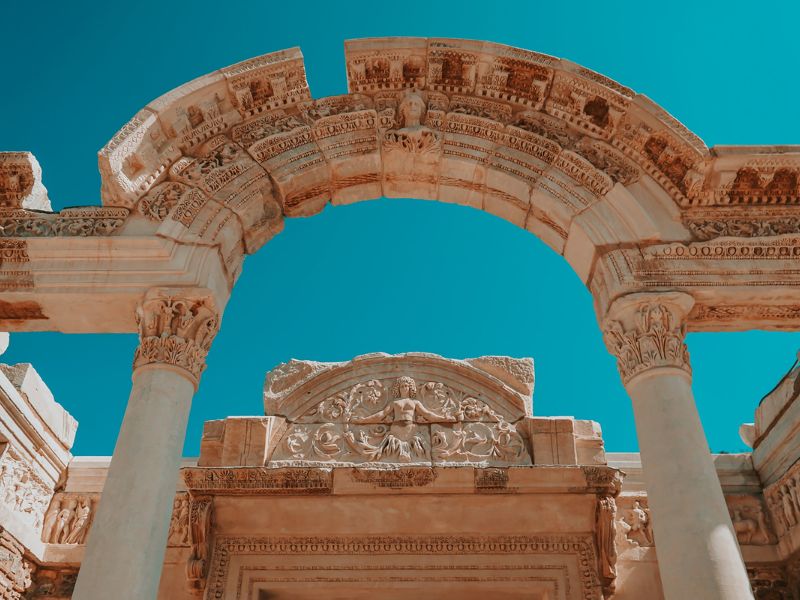
The architrave of the vestibule boasts a frieze of acanthus leaves and other botanical motifs, showcasing the intricate craftsmanship typical of the period.
The interior frieze of the vestibule, with original segments preserved in the Selçuk Museum, depicts the founding myth of Ephesus, including Androklos hunting boars, accompanied by gods and Amazons at a Dionysian festival.
The stylistically divergent right part of the frieze likely originates from another building, relocated here post-reconstruction following a 4th-century earthquake.
Reconstruction and Preservation
Today, visitors primarily see the reconstructed entrance porch, painstakingly pieced together by archaeologists in the 1950s. This ornate portico, once covered with intricate marble reliefs and inscriptions, remains a testament to the temple’s former glory.
While the main chamber’s decoration has not survived, the architectural form, described as prostyle tetrastyle in antis, remains discernible. This format includes a pronaos supported by four frontal columns flanked by side walls, enclosing a barrel-vaulted cella measuring 7.50 meters wide and 5 meters long.
Two low steps from the sloped street lead into the porch, flanked by a facade’s entablature composed of 23 marble blocks, originally surmounted by a pediment.
Only the corners of this pediment endure, featuring a central arch, a stylistic innovation believed to originate from the Near East, often termed “Syrian.” The arch’s keystone is decorated with a relief bust of Tyche.
Entrance and Interior
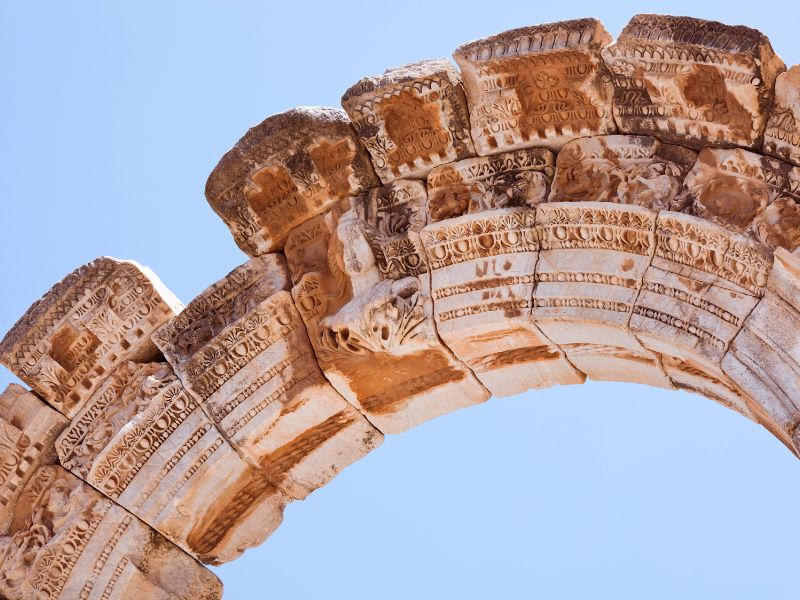
The entrance, supported by pillars and unfluted monolithic columns with composite capitals, exudes a powerful yet refined presence. The interior walls of the porch, adorned with marble and inclusive of a decorated doorway, lead into the cella where a statue of Emperor Hadrian likely resided.
Above this doorway, the marble lunette panel features a relief thought to depict the Gorgon Medusa. A frieze along the top of the walls narrates scenes from Ephesus’s history and founding legends.
Originally from the 4th century AD, these reliefs were added during the temple’s restoration and are now preserved in the Ephesus Archaeological Museum.
Discovery and Archaeological Work
Discovered in 1956 by the Austrian Archaeological Institute, led by Franz Miltner, and reconstructed between 1957-1958 with architect Karl Heinz Göschl, the Temple of Hadrian stands as a testament to the enduring legacy of Ephesus’s architectural and cultural heritage.
The Temple’s Legacy
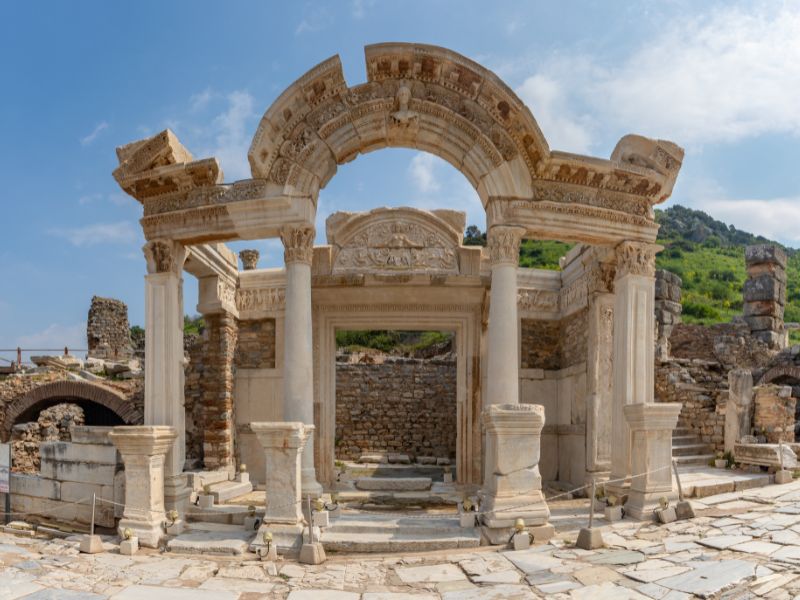
Historical Significance and Role in Ephesus
The Temple of Hadrian in Ephesus stands as one of the best-preserved and most beautiful structures on Curetes Street, a testament to the architectural and cultural achievements of ancient Ephesus. Its significance extends beyond its physical beauty, representing a blend of Roman imperial power and local religious practices.
The temple not only honored Emperor Hadrian but also reinforced the city’s devotion to Artemis, creating a space where imperial and local identities intersected. The temple’s historical importance is further underscored by its role in the daily lives of Ephesus’ inhabitants.
It served as a place of worship, a symbol of civic pride, and a testament to the city’s prosperity and cultural richness.
Preservation and Modern Importance
Today, the Temple of Hadrian in Ephesus continues to be a focal point for historians, archaeologists, and visitors from around the world. Its preservation allows us to explore and understand the intricate details of Roman architecture and Ephesian history.
The ongoing efforts to maintain and restore the temple ensure that future generations can appreciate its beauty and significance.For visitors to Ephesus, the temple offers a tangible connection to the past, inviting exploration and contemplation. It stands as a reminder of the city’s storied history and its enduring legacy in the annals of ancient civilization.
Conclusion
The Temple of Hadrian in Ephesus is more than a mere architectural marvel; it is a narrative woven into stone, a reflection of cultural symbiosis, and a testament to the grandeur of ancient Rome and its provinces. This iconic structure invites us to delve deeper into the past, exploring the lives and legacies of those who walked its halls and revered its deities.

